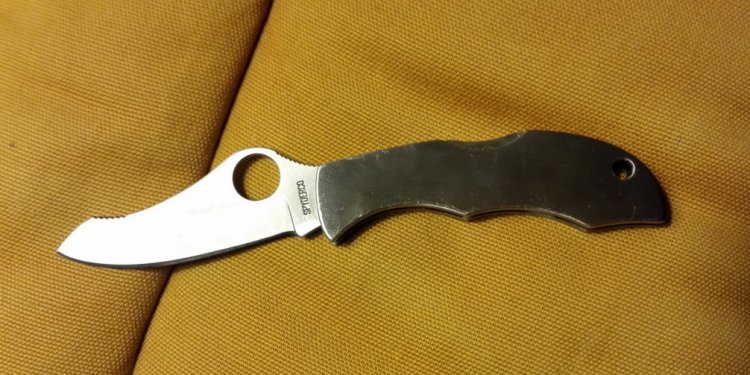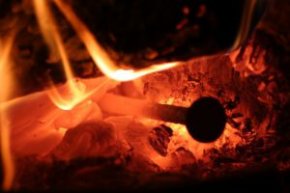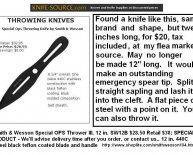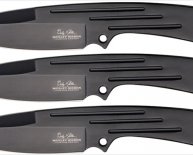
ATS-55 steel
 In my Last Post, The Secrets of Steel- Part 2, I explained the most popular High Carbon Steels used for knife making today. Now, I will admit a preference for High Carbon Steel fixed blades, mainly because I like the appeal of traditional carbon steel blades. I don’t mind the extra maintenance involved in High Carbon Steel blades. The qualities of certain High Carbon Steels make them easier to work and temper, when building knives in my own workshop. Of course, this is my personal opinion and other people may disagree, but Stainless Steel blades can be fantastic for knives that need to be versatile like an everyday carry pocketknife. Personally, I need my pocket knife to be able to open letters, cut food, trim a thread and then sit un-used in my pocket for the rest of the day without any additional maintenance. Stainless Steel is great for those purposes. It’s corrosion resistant, easy to clean and esthetically pleasing.
In my Last Post, The Secrets of Steel- Part 2, I explained the most popular High Carbon Steels used for knife making today. Now, I will admit a preference for High Carbon Steel fixed blades, mainly because I like the appeal of traditional carbon steel blades. I don’t mind the extra maintenance involved in High Carbon Steel blades. The qualities of certain High Carbon Steels make them easier to work and temper, when building knives in my own workshop. Of course, this is my personal opinion and other people may disagree, but Stainless Steel blades can be fantastic for knives that need to be versatile like an everyday carry pocketknife. Personally, I need my pocket knife to be able to open letters, cut food, trim a thread and then sit un-used in my pocket for the rest of the day without any additional maintenance. Stainless Steel is great for those purposes. It’s corrosion resistant, easy to clean and esthetically pleasing.
The biggest drawbacks of Stainless Steels compared to High Carbon Steel are that they aren’t very strong, flexible (they tend to break or crack easily), they generally don’t produce a very wear resistance/sharp edge and they won’t accept a variable (differential) temper. All of these small combined disadvantages make Stainless Steel blades less effective at doing heavy or intensive tasks such as batoning, carving and splitting.
As I mentioned in my last post The Secrets of Steel- Part 2, Stainless Steel is considered to be any steel that has more than 13% chromium content. Chromium content makes the steel much more corrosive resistant but at the same time decreases wear resistant and toughness. Nickel may be added to the composition of Stainless Steel to offset the decrease in the steel’s toughness.
- 420 Stainless Steels- 420 steels represent the low end of Stainless Steels. They have very low carbon content (< .5%) and are very corrosion resistant. 420 steels are very soft and have very low wear resistance. Because of this, 420 steels don’t temper well or take/hold an edge very well. On the positive side 420 steels are very tough and very easy to work because of how soft they are.
- 440 Series- The 440 steels are a higher quality Stainless Steel. These steels will harden when tempered and have more wear resistance than 420 steels, but just barely enough to be acceptable. The other advantage of the 440 family compared to 420 is the increased strength.
- 154 CM Steel- 154 CM is a high quality steel (super steel), which has a slightly higher carbon content and is a great improvement over 440. It’s a hard steel that hold an edge well. It has reasonably good toughness for how hard it is and has reasonable corrosion resistance for the carbon content.
- 8Cr MoV14 and 9Cr MoV Steels- Chinese made steels that are similar to 440 but with a higher carbon, cobalt and vanadium content to add more strength to the blade.
- The AUS Series- Japanese made steels are another improvement on 440. The AUS Series adds vanadium to the content to add strength, make the steel easier to sharpen and to retain an edge.
- The ATS Series- Very similar to 154CM steel (super steel), the ATS family are considered high quality steels. ATS-34 has more desirable qualities than ATS-55 due to ATS-34 vanadium content. Many high quality knives are made from ATS-34.
- VG 10- Another high quality Stainless Steel (super steel), VG-10 is very popular in modern knife making. Again, vanadium content is added to this steel to increase the steels toughness and strength. This steel is known to be very rust resistant and wear resistant. This steel will take and hold an edge well.
Well, those are the most commonly used Stainless Steels for knife blades. Hopefully this has helped you understand the different qualities and functionality of the Stainless Steels out there today. Even though I do prefer High Carbon Steel, I think a good Stainless Steel blade has its place in anyone’s pocket, as long as you’re in the right setting.
I know I didn’t list all available Stainless Steels, but I encourage questions and comments about this post or any other steels I didn’t mention in the comment section. I’ll try to answer any questions you have. Stay an Edge Above the Rest.


















